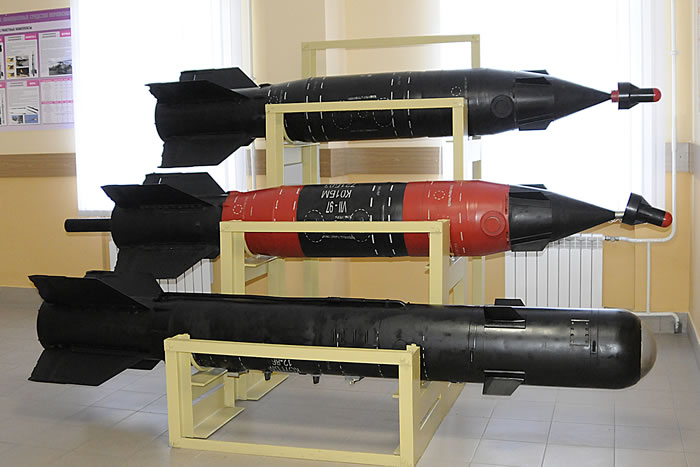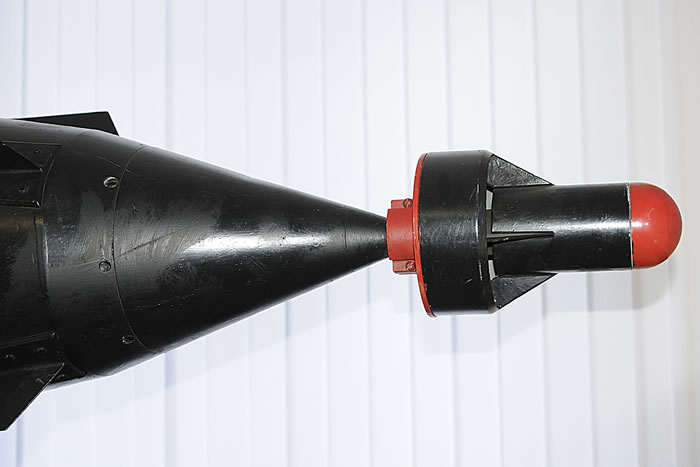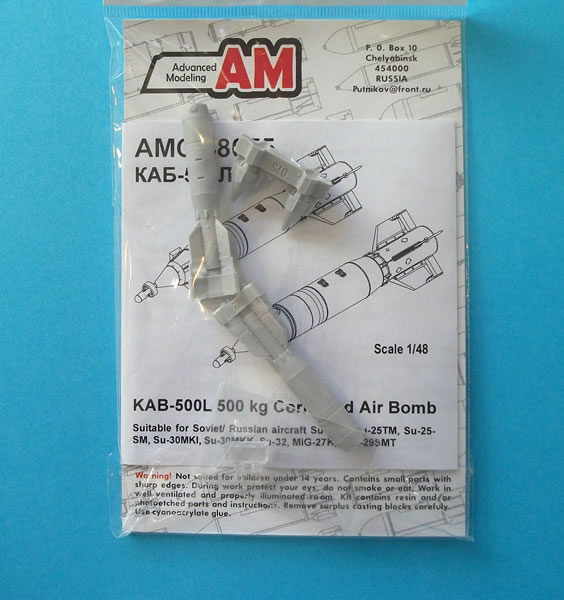KAB-500Kr & KAB-500L Corrected Air Bomb

Advanced Modeling, 1/48 scale
S u m m a r y : |
Catalogue Number |
Advanced Modelling Item Nos.
AMC 48074 – KAB-500Kr Corrected Air Bomb
AMC 48075 – KAB-500L Corrected Air Bomb |
Contents and media |
AMC 48074 -12 gray resin & 2 clear resin parts. Decal & instruction sheets
AMC 48075 - 8 gray resin & 2 clear resin parts. Decal & instruction sheets. |
Scale |
1/48 |
Price: |
Available online from these stockists
AMC 48074:
AMC 48075:
|
Review Type |
First Look |
Advantages: |
High quality Russian resin weapons. |
Disadvantages: |
Modelling skills required for a small scratch building task. |
Recommendation: |
Great missiles and will look a treat under a wide range of Russian fighter bombers. |
Reviewed by Marcus Thornley

Eduard's BRASSIN 1/72 Bullpup B is available online from Squadron.com
The Company
Advanced Modeling is a newer company that many modellers may not yet be aware, here is some previously provided information
The team at Advanced Modeling’s staff members are all skilled modellers focused on producing really accurate modeling products. When developing 3D models they use original technical drawings and check their results against real ammunition! The company does not currently have a website as all efforts are focused on expanding their product range.
Distribution is through a growing number of on-line stockists and distributors; currently these include:
The Missile

Russian Precision Guided Munitions (PGMs) in the 500 Kg class utilising Electro-Optical in the case of the KAB-500Kr or Semi-Active Laser homing for the KAB-500L and compatible with a wide range or Russian/Soviet legacy aircraft such as MiG-27K, MiG-29SMT, Su-24M, Su-24TM, Su-25SM, Su-30MKI Su-30MKK, Su-32 & Su-34.

Source: Ausairpower
Advanced Modeling may be a fairly new addition to the world of after market resin accessories but they are not slow in filling their catalogue with a wide array of Russian aerial weapons for the modeller to load up their Russian attack aircraft.
These two items we are reviewing are part of that growing catalogue and look to be pretty neat.

After years looking at smooth bodied Paveway series bombs and the relatively more recent GBU laser guided family, the angular and brutal lines of their Russian equivalents are a bit of a shock. Subtle they are not.
As provided the kits will each build and decal two bombs. Packaged in multiple single use cellophane bags are the resin pieces, clear resin, Photo-Etch (PE) & decals, instructions and backing card.
The resin has a nice smooth finish with no imperfections or air bubbles. The detailed areas are well done with fine engraved lines for the panel joins and raised access panels with visible fasteners. The finely cast fins are all happily free from wave effect that can sometimes accompany thin castings.
At first glance I did think the large section of each of the bombs was the same but a second look shows this not to be the case, although the guidance fin section at the rear of both bombs could be a generic part. The -500Kr is effectively a common diameter down its length. The -500L has tapering sections fwd and aft and a greater diameter through the mid section. On both the -500Kr & -500L the casting block will need to be cut away with care so the fins are not damaged. The casting block is in the X form so there is packaging protection for the fins and there is a wafer of resin between this and the rear of the fins. Once the casting block is clear the rear surface will need to be cleaned up so it is nice and flat for the PE that is fitted there.
There is a cable conduit running along the belly of the bomb casing, the instructions clearly show where this runs so it should be just a matter of care with the clean up as the wafer for this runs back past the turn down into the guidance unit. The front face of these sections has a tapered recess with a proud key.
The PE parts in both these sets is the same item and carries the part number of the KAB-500Kr set. It is two pieces, one per bomb and shows the detail of the rear face of the bomb.
From this point on the parts in the kits start to differ quite obviously. The KAB-500Kr has a small casting block with eight quite small but exquisitely cast items. Four of these are mounting lugs and the remaining four are two different types of locating points (fwd and aft) for the bomb as it is restrained against the pylon. The photo of the bomb loaded on the pylon show that the pylon sway braces are wound out in deference to these items. The bomb casting has relief detail showing their positions
The KAB-500Kr is the electro-optically guided version and has a fwd seeker section with 4 canard fins in cruciform layout. At the base of this section against the casting block is a tapered section with a key way. This is designed to fit into the recess at the front of the main bomb section locating and aligning the two sections. The front of this section has a quite nice representation of the electro-optical seeker. It will benefit from detail painting as the lenses are optically crystal clear and magnify the seeker detail.
The parts are rounded out with the small but densely packed decal sheet which is very nicely printed, under magnification the text is all legible, but not understandable to this almost monolingual.
The KAB-500L is the laser guided variant. The fwd section has 4 canard fins in cruciform layout and is sharply tapered to a point at the nose. Again at the base it has a tapered section with key way for location and alignment into the main section of the bomb. Moulded in clear resin are the two laser seekers. From a complete geek point of view these have to be my favourite pieces in the kit. The annular aerofoil is moulded very delicately and true to life, looking from the nose you can see through the slots between the aerofoil and the seeker. Once separated from the casting block the rear face will need preparing for attachment to the nose section of the bomb
Some old fashioned modelling skill is required here. The instructions show where a short stem is required fix the laser seeker to the nose of the bomb, or as the instructions refer to to it, the 'target coordinator' and the dimensions for this item. There is no piece provided for this so the modeller will need to scratch build this themselves. Some fine rod and tube should suffice or even just a piece of stretched sprue and a little CA, remembering that if the bomb is being modelled for carriage on a stationary aircraft the seeker should droop due to the effect of gravity.
The remaining four pieces are the mounting lugs, positions for which are shown engraved on the bomb casing.
A small but comprehensive decal sheet is included with each set and covers the markings . The decals are well printed in register with good colour density and legible. Admittedly you will need a magnifier and the ability to read Cyrillic script to know if it makes any sense. I am sure it does, Advanced Modeling is a Russian enterprise after all.
The instructions are printed on fold out sheets glued to the backing card. The text is bilingual, in Russian and English. With background, assembly, painting instructions and decal placement.
An FS reference is just for modellers to be able to use their cross reference charts to their favourite paint. Reference to the photos at the top of this review were provided by Advanced Modeling and show bombs with their red safety covers in place.
Two well thought out accessory sets, nicely cast with a very complete decal sheets. Acknowledging the modelling skills required to prepare the small resin parts and the small amount of scratchbuilding required on the -500L variant, these are highly recommended.
Thanks to Advanced Modeling for the review sample
Review Text Copyright © 2015 by Marcus Thornley
Page Created 16 June, 2015
Last updated
16 June, 2015
Back to HyperScale Main Page
Back to Reviews Page

|
